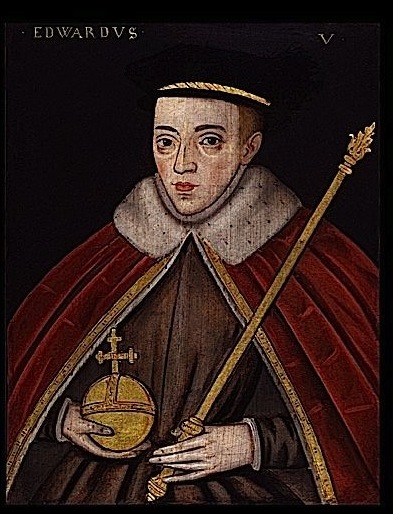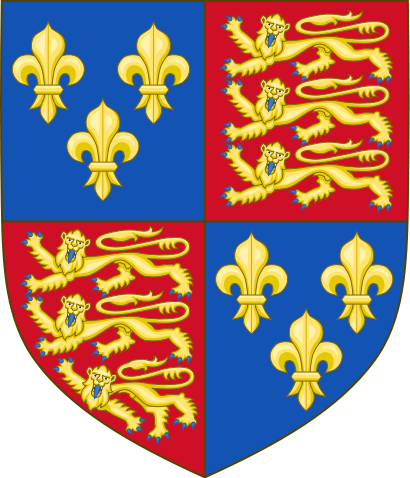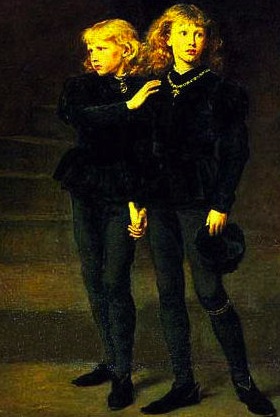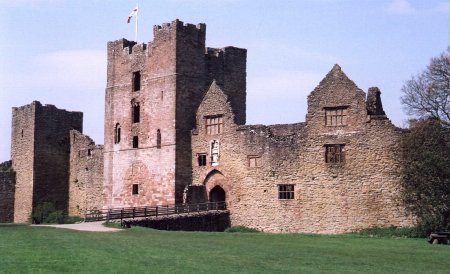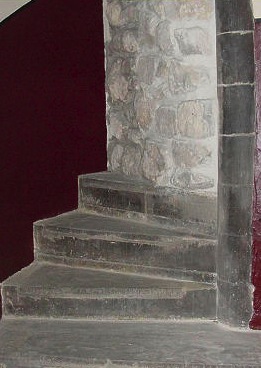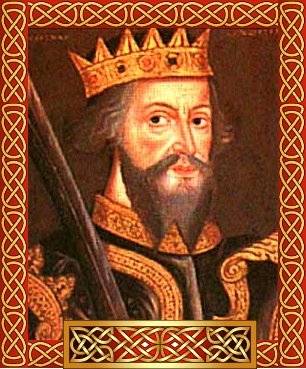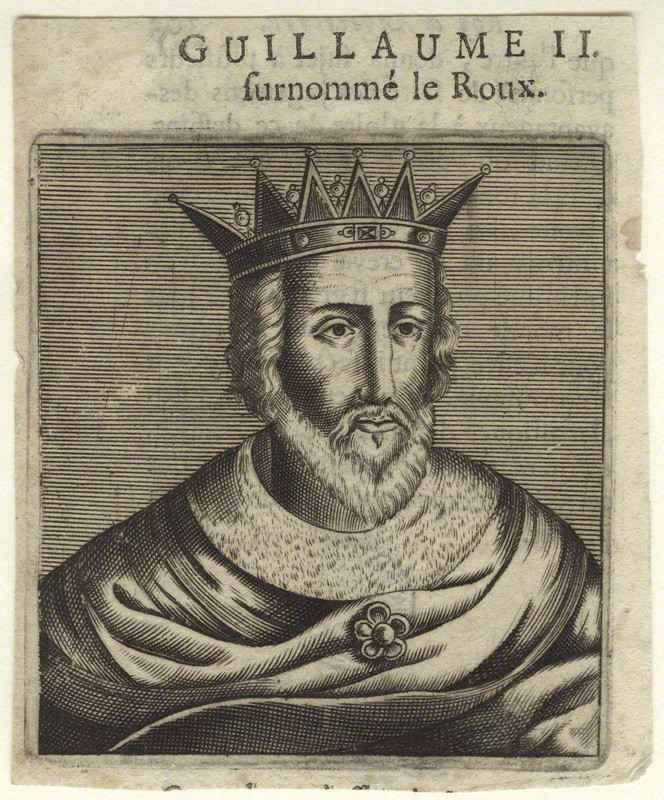Name: King Edward V
Born: November 4, 1470 at Westminster
Parents: Edward IV and Elizabeth Woodville
Relation to Elizabeth II: 13th great-granduncle
House of: York
Ascended to the throne: April 9, 1483 aged 12 years
Crowned: Not crowned
Married: Never Married
Children: None
Died: September, 1483 at Tower of London (murdered), aged 12 years, 9 months, and 27 days
Buried at: Tower of London
Reigned for: 4 months, and 23 days
Succeeded by: his uncle Richard III
King of England 1483. Son of Edward IV, he was deposed three months after his accession in favour of his uncle (Richard III), and is traditionally believed to have been murdered (with his brother) in the Tower of London on Richard’s orders.
Edward V (2 November 1470 – 1483?) was King of England from 9 April 1483 until the accession of Richard III on 26 June 1483 (as confirmed by the parliamentary act entitled “Titulus Regius”). His reign was dominated by the influence of his uncle, Richard. Along with his younger brother Richard of Shrewsbury, Duke of York, Edward was one of the Princes in the Tower, who disappeared after being sent (ostensibly for their own safety) to the Tower of London. Responsibility for their deaths is widely attributed to Richard III, but the actual events have remained controversial for centuries.
The mysterious disappearance of a boy claimant to the English throne, possibly at the hands of his uncle, mirrors the presumed death of Arthur, Duke of Brittany, in 1203.
Along with Edward VIII, and the disputed Matilda and Jane, Edward V is one of only four English monarchs since the Norman Conquest never to have been crowned. If, as seems likely, he died before his fifteenth birthday, he is the shortest-lived monarch in English history (his great-nephew Edward VI died in his sixteenth year).
| Timeline for King Edward V |
| 1483 | On the death of Edward, the crown passes to his 12 year old son, Edward V |
| 1483 | Edward is declared illegitimate and deposed in favour of his uncle Richard Duke of Gloucester. |
| 1483 | Edward and his younger brother Richard of York are imprisoned in the Tower of London. After a few months the princes are never seen again and are believed to have been murdered. |
Early Life
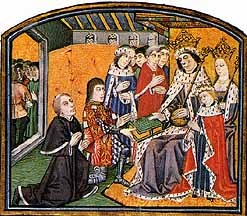 The eldest son of Edward IV and Elizabeth Woodville, Edward V was born at Westminster Abbey on 28th April, 1470, where his mother had taken sanctuary during the brief restoration of the Lancastrian king, Henry VI. Yorkist fortunes were at a low ebb, Edward’s father had been forced to flee the country and his mother and sisters had taken sanctuary within the Abbey. Henry VI, with characteristic kindness, would not countenance any violence toward the child or his mother. On the return of Edward’s father, Henry VI was again deposed.
The eldest son of Edward IV and Elizabeth Woodville, Edward V was born at Westminster Abbey on 28th April, 1470, where his mother had taken sanctuary during the brief restoration of the Lancastrian king, Henry VI. Yorkist fortunes were at a low ebb, Edward’s father had been forced to flee the country and his mother and sisters had taken sanctuary within the Abbey. Henry VI, with characteristic kindness, would not countenance any violence toward the child or his mother. On the return of Edward’s father, Henry VI was again deposed.
Edward was sent to Ludlow Castle, near the borders of Wales, for his education. On the death of his father on 9 April, 1483, the new King journeyed to his capital with his maternal uncle, Anthony Woodville, appointed his governor, his half-brother Sir Richard Grey and a small retinue.
The Usurpation of Richard of Gloucester
His progress was interrupted at Stony Stratford by his paternal uncle Richard, Duke of Gloucester and his distant cousin, Henry Stafford, Duke of Buckingham. Woodville, Grey and others of the king’s escort were sent to Richard’s power base in the north. Edward, who seems to have been a promising and intelligent youth, objected, but was humiliatingly powerless. Anthony Woodville and Richard Grey, despite reassurals to the contrary, were later executed on Richard of Gloucester’s orders.
The young King, now in the custody of his uncle Gloucester and Buckingham, continued on his progress to London. News of the dramatic occurrences at Stony Stratford raced ahead of them, Queen Elizabeth Woodville, in a state of agitation, fled to Westminster Abbey with her daughters and her younger son, Richard, Duke of York. Avaricious as ever, she took all her possessions into sanctuary with her.
Gloucester and Buckingham entered London with the young king and a large body of armed men from the north. Panic spread, most people had been taken by surprise and astonishment was rife at the speed of events. An unmistakable atmosphere of coup d’etat gripped the city. While the grasping Woodvilles had been unpopular, King Edward IV had been much loved by the people, and therefore most were loyal to his son. Richard of Gloucester eased apprehension by explaining he was only countering a Woodville conspiracy aimed at himself and “the old nobility of the realm”. This explaination was generally accepted and the fears which had gripped the city were calmed.
King Edward V was lodged in the Tower of London ostensibly awaiting his coronation. There was nothing sinister detected in this at the time when the Tower was a royal residence as well as a prison. On the pretext that his brother required his company and the Queen was being foolish, the ten year old Richard, Duke of York, was removed from the safety of sanctuary at Westminster and taken to join him in the Tower.
At a meeting of the council at the Tower on the thirteenth of June, ostensibly to discuss Edward V’s coronation, Gloucester, the Lord Protector, had William, Lord Hastings suddenly and unexpectedly arrested on a charge of treason. Hastings, while he detested the Woodvilles, had been a close friend of Edward IV and would never have countenanced the disinheriting of his children. He was executed, without trial, the same day on a block of wood.
The legitimacy of the young Edward V then began to be actively questioned, and the old claim of Edward IV not being the true son of Richard, Duke of York was resurrected by Buckingham, who stated that the late King’s true father had been an archer named Blackburn, who was supposed to have had an adulterous affair with Cecily, Duchess of York.
He also argued that the late King Edward IV’s marriage to Elizabeth Woodville was invalid, due to Edward’s previous troth plight to Lady Eleanor Butler, rendering both Princes bastards. He then called on Richard to ascend the throne as the true heir of York, pointing out his resemblance to his father. After an initial feigned show of reluctance, Richard then accepted and was crowned in his nephew’s place. Many saw through this dissembling, but since he was now all powerful, none were in a position to oppose him directly.
The Murder of the Princes in the Tower
The two young princes had been seen playing in the Tower gardens at various times until then. Gradually, they began to appear less frequently. The last person to see them alive was Edward V’s physician, Dr. Argentine, who had attended him at the Tower and found him in a state of abject melancholy.
Contemporary accounts of the disappearance of the ‘Princes in the Tower’
Dominic Mancini, who left England in July, 1483, informs us;-
‘He and his brother were withdrawn into the inner apartments of the Tower proper, and day by day began to be seen more rarely behind the bars and windows, till at length they ceased to appear altogether. A Strasbourg doctor, the last of his attendants, whose services the King enjoyed, reported that the young King, like a victim prepared for sacrifice, sought remission of his sins by daily confession and penance, because he believed that death was facing him. Already there was a suspicion that he had been done away with. Whether however, he has been done away with, and by what manner of death, so far I have not at all discovered.’
The Croyland Chronicle, written in the spring of 1486, confirms these rumours:-
‘A rumour,’ it states ‘was spread that the sons of King Edward had died a violent death, but it was uncertain how’.
Robert Ricart, Recorder of Bristol made an entry in his ‘Kalendar’ for the year ending September, 1483:-
‘In this year the two sons of King Edward were put to silence in the Tower of London.’
Historical notes compiled by a citizen of London before the end of 1488 for the year ending November, 1483, record that::-
‘they were put to death in the Tower of London.’
Dispute has raged ever since with regard to the fate of Edward V and his brother. The traditionalists believe that they were killed on their uncle Richard’s orders. While the revisionists argue that Richard was cast into the role of villain by Tudor propaganda and that his successor, Henry VII, or Buckingham, had equal cause to remove the two boys, as they stood as much in their path to the throne as they did in Richard’s.The Duke of Buckingham also stood in the line of succession, he was descended from Thomas of Woodstock, Duke of Gloucester, the youngest son of Edward III.
Much evidence to support both claims has been raised. At a distance of more than five hundred years it is impossible to state with certainty who was responsible for ordering the murder of Edward V and his young brother, all that can be said with certainty is that rumour was rife at this time that they had been done away with and that they were never seen alive again.
The Tudor humanist scholar, Sir Thomas More, writing forty years later, provides an early account of the young Prince’s fate. More himself was five at the time of Bosworth, he had however, access to many people who were alive at the time and who participated in public affairs during Richard’s reign. Although, admittedly, some of these and particularly Dr Morton would have been partisan.
More relates to us that the order was given by Richard, whilst on progress to Gloucester following his coronation, to one John Green, to carry a letter to Sir Robert Brackenbury, then Constable of the Tower, to kill his nephews, Brackenbury however, refused to carry out the deed, although he did later fight by Richard’s side at Bosworth.
The king then approached Sir James Tyrrell, who, being an ambitious man, wanted to rise in his service and was more receptive. Richard sent him to the Tower with an order that the keys be surrendered to him for one night. More further tells us he employed two men to carry out the murder, Miles Forest ‘a Fellow fleshed in murder before time’ and John Dighton ‘a big broad square knave’. They, it is reported, smothered the boys under the feather bed and pillows.
The bodies were then reportedly buried ‘at the stair foot meetly deep in the ground, under a great heap of stones.’ A John Green of Warwickshire who received a general pardon from the crown in September, 1483 has been traced. Forest has been discovered to be a a Keeper of the Wardrobe at Barnard Castle, the home of Richard’s mother, Cecily, Duchess of York. More reports that due to Richard’s uneasy conscience, the children’s bodies were later disinterred and buried elsewhere.
James Tyrrell was later appointed Master of the King’s Henchmen. Tyrrell was supposed to have confessed to the murder prior to being hung for another offence, in 1502, during the reign of Henry VII. It is puzzling, however, that Henry VII did not publish this confession to clarify the matter and take advantage of the opportunity presented to blacken the reputation of his hated rival. To muddy the waters further, in the summer of 1486, only one year after Bosworth, Henry VII himself issued two pardons in the name of James Tyrrell.
Revisionists point to the fact that Elizabeth Woodville would never have surrendered her daughters to Richard’s keeping if he had murdered her sons, the Princes. It should be remembered that prior to this event he had already executed her other son, Sir Richard Grey.
The conduct of Henry VII toward Elizabeth Woodville, then his mother-in-law, adds to the enigma. For reasons which remain unclear, Henry quarreled with the Dowager Queen and in 1487, forfeited all her possessions and had her removed to a nunnery. Speculation has been made that this may have been because she had discovered that he had murdered her sons and therefore had to be isolated to be kept quiet. It could equally have been because of her involvement in the pretenders plots.
The Bones in Westminster Abbey
In 1674, workmen employed in demolishing a staircase within the Tower of London, leading to the chapel of the White Tower, made the discovery of the bones of two children in an elm chest, at around a depth of ten feet. They were originally thrown aside with some rubble until their significance as the possible bones of the two princes was recognised. A number of accounts survive relating to the discovery of these bones, the following account, written on evidence presented by John Knight, Chief Surgeon to Charles II, was published in 1677:-
“Upon Friday the … day of July, An. 1674 …in order to the rebuilding of the several Offices in the Tower, and to clear the White Tower of all contiguous buildings, digging down the stairs which led from the King’s Lodgings, to the chapel in the said Tower, about ten foot in the ground were found the bones of two striplings in (as it seemed) a wooden chest, which upon the survey were found proportionable to ages of those two brothers viz. about thirteen and eleven years. The skull of one bring entire, the other broken, as were indeed many of the other bones, also the chest, by the violence of the labourers, who….cast the rubbish and them away together, wherefore they were caused to sift the rubbish and by that means preserved all the bones. The circumstances of the story being considered and the same often discoursed with Sir Thomas Chichley, Master of the Ordinance, by whose industry the new buildings were then in carrying on, and by whom the matter was reported to the King.”
Charles II, then the reigning monarch, asked the architect Sir Christopher Wren to design a white marble container and they were reverently placed in the Henry VII chapel at Westminster Abbey, close to the tomb of the Prince’s sister, Elizabeth of York.
Portrait of the Princes in the Tower. Paul Delaroche (1831)
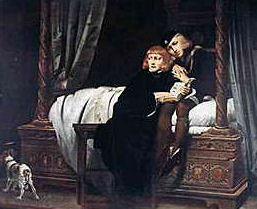 Due to historical controversy which continued to surround the matter of the fate of the Princes in the Tower, George V gave permission for the exhumation of these bones in 1933. An examination was conducted on the bones by Lawrence Tanner MD, OBE, the Abbey archivist, Professor William Wright, President of the Anatomical Society of Great Britain and Dr George Northcroft, then president of the Dental Association.
Due to historical controversy which continued to surround the matter of the fate of the Princes in the Tower, George V gave permission for the exhumation of these bones in 1933. An examination was conducted on the bones by Lawrence Tanner MD, OBE, the Abbey archivist, Professor William Wright, President of the Anatomical Society of Great Britain and Dr George Northcroft, then president of the Dental Association.
Professor Wright concluded that on the evidence of the ossification development of the bones of the vertebrae, he believed these were the bones of two children, the eldest aged twelve to thirteen and the younger nine to eleven. The heights of the two children were calculated to be four feet nine and a half inches and four feet six and a half inches respectively, somewhat taller than their age estimates suggested. (The prince’s father, Edward IV, stood at six feet four inches tall). They further stated that a large red stain on the skull of the elder child reaching from below the orbits to the angles of the lower jaw was consistent with death by suffocation, and that congenital missing teeth and certain bilateral Wormian bones (islands of bone) of unusual size and similar shape on both crania were evidence of consanguinity. The lacrimal bone, smallest and most fragile of the face, of one of the boys was abnormal, which suggested, stated Wright, that he had ”cried his eyes out.”
Dr. Northcroft, after an examination of the teeth, (the most reliable method for determining age) was in agreement with Wright’s findings. Both sides of the lower jaw of the elder child, presumed to be Edward V, exhibited extensive evidence of the bone disease, osteomyelitis, a chronic and in medieval times, incurable condition.
The Tanner and Wright report and accompanying photographs of the bones have been subject to expert scrutiny on many occasions since then. Modern conclusions vary. There is consensus of opinion among modern experts that Wright’s determination of the ages of the skeletons and the age differential between the two sets of bones is approximately correct, although great differences of age calculated by the development of bones and teeth has been observed in studies. Later reports claim to be unable to determine the sex of either skeleton. Determination of consanguinity by congenitally missing teeth or bilateral Wormian bones remains disputed although the skull of Anne Mowbray, the younger prince’s child bride who died in 1481, a distant relative of the princes, also displayed similar congenital missing teeth. As regards the staining which is present on one of the skulls, without chemical testing it remains unproven that it is actually a blood stain and modern experts deny it being proof of suffocation.
In the absence of modern carbon dating or DNA analysis on the forensic evidence of the bones, it is still not possible to say that these are the bones of Edward V and his brother. The Abbey authorities have to date refused a second examination.
Credits
Wikipedia
http://www.englishmonarchs.co.uk/
http://www.britroyals.com/

